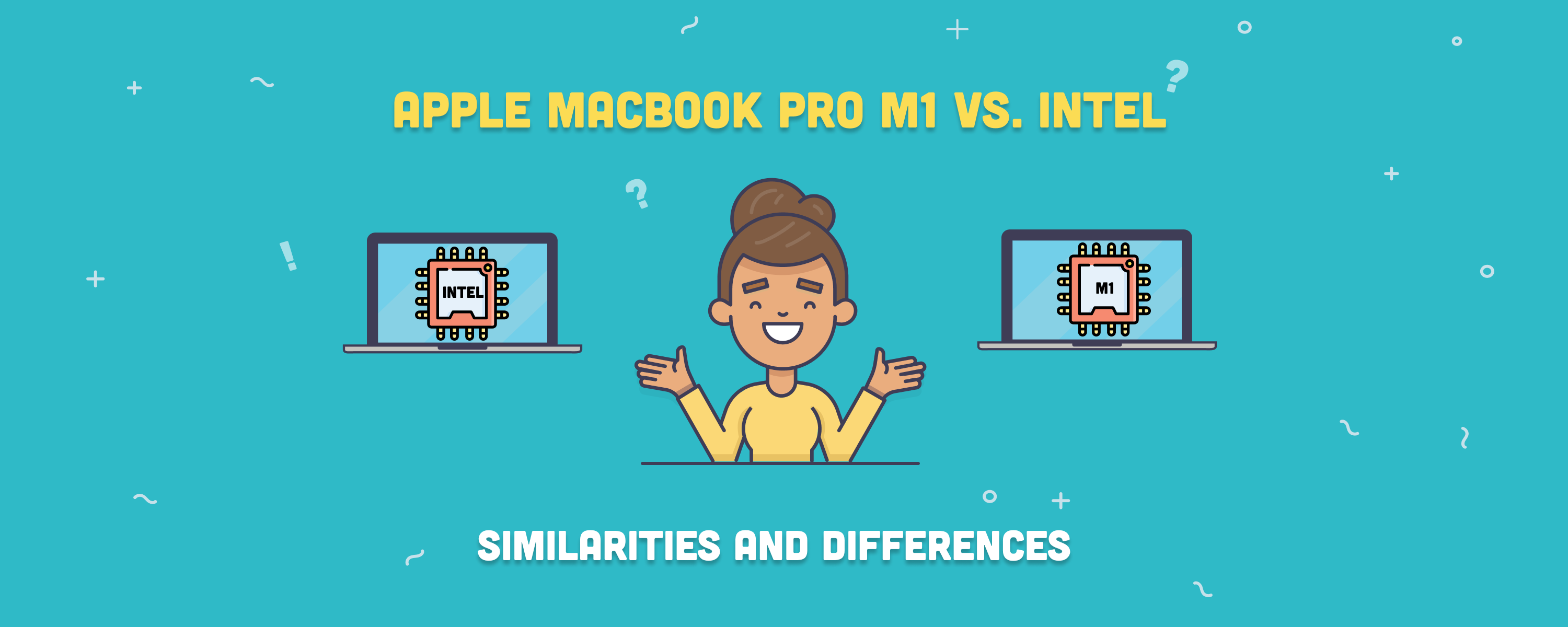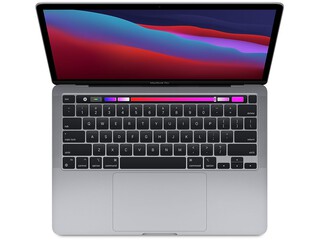Much like the iPhone, iPad, and Apple Watch all run on Apple’s processors, the company is transitioning its Mac lineup away from Intel and toward its in-house chips. So, is it still worth going for the Intel MacBook Pro, or does it make more sense to leap to Apple Silicon now? This guide aims to help answer how to decide between the MacBook Pro M1 and Intel models; taking the 13-inch model as a reference.
Table of contents
Apple M1 MacBook Pro vs. Intel: Overview
After the introduction of the M1 chip, Apple’s MacBook Pro laptops now come in two variants: those powered by Apple’s M1 chip and those that run on Intel’s processors. Competition is high, and that’s one of the reasons why Apple designed the M1 chip.
The 13-inch MacBook Pro powered by M1 succeeds Apple’s entry-level Intel MacBook Pro and is virtually identical in all but the innards. The MacBook Pro M1 and Intel MacBook Pro that Apple still sells both share the same uniform, slab-like design, Magic Keyboard, and Touch Bar with Touch ID.
| MacBook Pro 13-inch (M1) | MacBook Pro 13-inch (Intel) | |
| Display | 13.3-inch Retina display | 13.3-inch Retina display |
| Processor | Apple M1 with 8-core CPU, 8-core GPU, and 16-core Neural Engine | Quad-core Intel Core i5 or Intel Core i7 with Intel Iris Plus graphics |
| Memory | 8GB, 16GB | 16GB, 32GB |
| Webcam | 720p with Apple ISP | 720p |
| Battery | Estimated up to 20 hours | Estimated up to 10 hours |
| Ports | 2 Thunderbolt / USB 4 ports | 4 Thunderbolt 3 USB-C ports |
| Audio | Studio-quality three-mic array with high signal-to-noise ratio and directional beamforming | Three-mic array with directional beamforming |
| Storage | 512GB, 1TB, 2TB | 512TB, 1TB, 2TB, 4TB |
A glance might make you think you’re looking at two identical laptops, but a closer inspection should tell a different story.
Display
Both MacBook Pro M1 and Intel models have the same 13.3-inch Retina display with 2560×1600 resolution, the same 720p FaceTime HD camera, the same-sized chassis, and speakers with Dolby Atmos support. They also come with Touch Bar, Touch ID, Magic Keyboard, and Force Touch trackpad.
CPU
Apple’s M1 processor is quite efficient and intimidating. It’s an 8-core CPU with four performance cores and four efficiency cores and comes with an 8-core GPU. Plus, the 16-core neural engine enhances specific machine learning algorithms.
On the other hand, the two high-end 13-inch MacBook Pro models continue to use 10th-generation Intel Core chips. Both standard configurations use a 2.0GHz quad-core processor, which can be customized to a 2.3GHz quad-core Core i7 processor. The Intel models feature Intel Iris Plus graphics.

By comparison, these components in the high-end Intel MacBook Pro are segregated on the logic board, which gives the M1 chip several performance advantages. When doing simple tasks like browsing the web or reading email, the MacBook Pro uses high-efficiency cores to preserve battery life; for more system-intensive tasks like photo and video editing, high-performance cores are used.
Compared to high-performance cores, the high-efficiency cores use a tenth of the power while still delivering the performance Mac users need for everyday tasks.
Webcam
The M1 MacBook Pro also has a better webcam than the Intel version. Although both laptops have a 720p camera, Apple’s M1 computers also have the company’s image signal processor. The M1 MacBook Pro’s webcam had much better lighting, bolder color, and less grain than the Intel MacBook Pro.
Memory and storage
If you need the most storage and memory you can get in an Apple laptop, your best bet is an Intel MacBook Pro. The M1 MacBook Pro has limited memory and storage since it can only be configured with up to 16GB of memory (RAM) and up to 2TB of storage.
Intel models can be upgraded to 32GB of RAM with up to 4TB of storage. Most people don’t need these upgrades, but they matter to professional videographers and photographers working with huge files and running multiple memory-hogging apps simultaneously.
Battery life
Battery life is the real deal when buying Apple’s M1 Pro laptop. The MacBook Pro 13-inch with Apple M1 doubles the quoted battery life of the MacBook Pro 13 with Intel hardware. The former claims up to 20 hours of battery life, while the latter model promises up to 10 hours between charges.
Both figures are a best-case scenario, so you can expect slightly less battery life in real-world use. Still, the Apple M1 chip is far more efficient. The battery size in each model is almost identical, and the endurance gains come from a lower power draw, not a larger battery capacity.
Performance
Apple says the M1 chip’s CPU is up to 2.8x faster than the Intel chip in the entry-level MacBook Pro it replaces. The GPU speeds are up to 5x faster than Intel’s integrated graphics in the former model. That said,
Apple hasn’t provided any performance comparisons with the existing high-end Intel MacBook Pro models. Nonetheless, recent Geekbench benchmarks share the following: the M1 chip has a 3.2GHz frequency and earns single-core scores that exceed 1700 and multi-core scores around 7500, making it faster than even 2019’s high-end 16-inch MacBook Pro models, which come with 10th-generation Intel Core i7 or i9 chips.
So say, the M1 chip in the entry-level MacBook Pro offers single-core performance that is better than any other available Mac and outperforms the Intel-based MacBook Pro models that it is sold alongside. However, it may not exceed them all in GPU performance. Even when emulating x86 under Rosetta 2, the M1 MacBook Pro is still faster than all previously released Macs.
👉 Related article: Why Is My Mac So Slow? 10 Ways To Speed Up a Mac (for Free!)
Ports
Another point of note is the addition of the Thunderbolt 3 USB-C ports on the M1 MacBook Pro, which also meet the USB4 specification. USB4 is less of a technical advance over existing Thunderbolt 3 ports. It attempts to unify the confusing array of definitions related to USB3 and generational variants.

It also represents Intel’s transition from a paid licensing scheme for its proprietary thunderbolt protocol to an openly licensed industry standard. This is why Apple has been able to develop its own custom Thunderbolt 3 controller for the M1.
Like Thunderbolt 3, USB4 can allocate different levels of bandwidth to video and data transfers (up to 40Gb/s) when required simultaneously. Despite the name change, there is little practicable difference for the end-user.
Design
Aside from the difference in ports, the Apple MacBook Pro M1 and the Intel models look identical. They’re the same size and thickness and offer the same color options: silver or space gray, although the Apple M1 model is lighter. They also share the same uniform, slab-like design, Magic Keyboard, and Touch Bar with Touch ID.
Microphone and speakers
The MacBook Pro M1 and Intel 13-inch machines feature the same stereo speakers with a high dynamic range, wide stereo sound, and support for Dolby Atmos playback. However, the Intel model has a three-mic array with directional beamforming. Apple describes the mic array in the M1 model as “studio-quality” with a high signal-to-noise ratio, which could tip the balance for you if you make a lot of video calls.
Software compatibility
Regarding software compatibility, Apple has been clear that macOS virtualization software will be the only way to run Windows and PC software on a machine powered by Apple Silicon. Apps designed for the iPhone and the iPad will run on Apple Silicon natively, meaning that you’ll be able to use many of your favorite iOS apps on the M1 MacBook Pro.
The above will depend on how third-party developers work to furnish Mac input controls like keyboard and mouse in their iOS apps. Still, the assumption is that most future Catalyst apps will accommodate both touch and Mac input.
Conversely, the Intel MacBook Pro only runs x86-64 code for Intel’s architecture. The same can’t be said for the M1 MacBook Pro, which can run both iOS and x86-64 software thanks to Apple’s Rosetta 2 translation layer. In some cases, apps built with x86-64 run faster in Rosetta 2 than on Intel Macs.
It’s worth noting that Apple considers Rosetta 2 a temporary solution for developers. At the same time, they remake their existing Intel-based programs to run on ARM-based Macs, meaning they will eventually need to create native apps for Apple Silicon machines.
Final thoughts
The M1 MacBook Pro’s speedy performance and long battery life alone make it the best choice for most people. If you need the most storage, ports, and memory you can get in an Apple laptop, your best bet is an Intel MacBook Pro. App compatibility is also a key component of choosing an Intel MacBook Pro.
Take a look at our compared M1 MacBook Pro refurbished deals at a discounted price:
Here, you can get your refurbished Intel MacBook Pro at the best prices:
We hope this guide has served you well. Don’t hesitate to also read our article with the 10 best MacBook accessories in 2024.
Happy buying!









